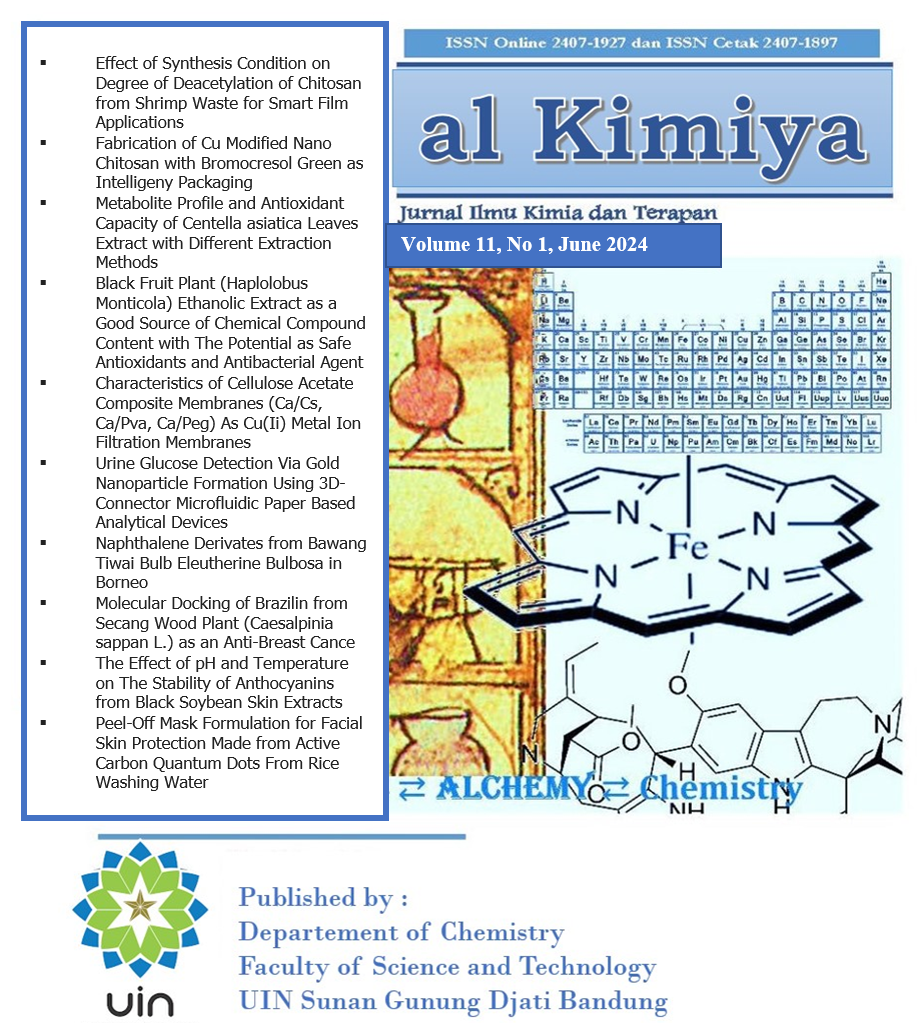Black Fruit Plant (Haplolobus Monticola) Ethanolic Extract as a Good Source of Chemical Compound Content with The Potential as A Safe Antioxidant and Antibacterial Agent
DOI:
https://doi.org/10.15575/ak.v11i1.34417Keywords:
Black fruit flesh, haplolobus monticola, antioxidant, antibacterial, toxicity.Abstract
References
Y. Subramaniam, & T. A. Masron, “Food security and environmental degradation: evidence from developing countriesâ€, GeoJournal, 86(3), 1141–1153, 2021. https://doi.org/10.1007/s10708-019-10119-w.
A. M. Loboguerrero, B. M. Campbell, P. J. M. Cooper, J. W. Hansen, T. Rosenstock, & E. Wollenberg, “Food and earth systems: priorities for climate change adaptation and mitigation for agriculture and food systemsâ€, Sustainability (Switzerland), 11(5), 2019. https://doi.org/10.3390/su11051372.
S. M. Wunderlich, & N. M. Martinez, â€Conserving natural resources through food loss reduction: production and consumption stages of the food supply chainâ€, International Soil and Water Conservation Research, 6(4), 331–339, 2018.
https://doi.org/10.1016/j.iswcr.2018.06.00.
A. Raposo, F. Ramos, D. Raheem, A. Saraiva, & C. Carrascosa, “Food safety, security, sustainability and nutrition as priority objectives of the food sectorâ€, International Journal of Environmental Research and Public Health, 18(15), 10–13, 2021.
https://doi.org/10.3390/ijerph18158073.
K. Lekitoo, E. Batorinding, P. A. Dimomonmau, W. F. Rumbiak, C. D. Heatubun, & H. Y. Lekitoo, â€Re-diversifikasi pangan di tanah papua bagian-1 pemanfaatan enam jenis tumbuhan hutan penghasil buah sebagai sumber bahan pangan di tanah papuaâ€, Badan Penelitian dan Pengembangan Kehutanan, Hal 232-235, 2012.
A. Ungirwalu, S. A. Awang, A. Maryudi, & P. Suryanto, â€Pengelolaan adaptif pemanfaatan buah hitam (Haplolobus monticola Blumea) etnis wandamen-papua (adaptive management utilization of black fruit (Haplolobus monticola Blumea) ethnic wandamen-papua)â€, Jurnal Manusia Dan Lingkungan, 23(2), 266, 2016. https://doi.org/10.22146/jml.18799.
E. Somar, â€The influence of abiotic factors on the content of secondary metabolites in leaves, 2014.
E. M. I. Siahaan, B. B. Santoso, E. Somar, M. Massora, L. Kimia, M. Fmipa, & U. Papua,†Uji aktivitas antibakteri dan skrining fitokimia ekstrak metanol buah hitam ( H . monticola . ) asal kabupaten teluk wondama antibacterial activity test and phytochemical screening of black fruit methanol extract ( H . Monticola ) from teluk wondamaâ€, Jurnal Natural, 17(2), 72–84, 2021. https://doi.org/10.30862/jn.v17i2.147
E. Somar, & L. A. Rahman, â€Ekstrak tannin daun buah hitam (Haplolobus sp) sebagai inhibitor alami korosi besi dalam larutan asamâ€, Jurnal Natural, 16(1), 61–65, 2020. https://doi.org/10.30862/jn.v16i1.78.
Sutiharni, S. M. Torey, L. E. Lindongi, & Y. Bodang, â€Uji toksisitas ekstrak daun piairawi (Haplolobus cf. monticola Husson.) asal teluk wondama dalam mengendalikan hama ulat tritip (Plutella xylostella L.) pada tanaman sawi (Brassica junceae L.)â€, Agropross : National Conference Proceedings of Agriculture, 4, 322–330, 2021.
https://doi.org/10.25047/agropross.2021.236.
Y. T. Toja, E. Suprayitno, & U. Yanuhar, “In silico potential black fruit seeds (haplolobus monticola) wondama local plant west papua barat as antibacterial Aeromonas hydrophilaâ€, Eurasian Journal of Biosciences, 14, 7125–7131, 2020.
Y. T. Toja, E. Suprayitno, Aulanni’am, & U. Yanuhar, “In vitro and ftir spectroscopy: local black fruit seed extract as antibacterial Aeromonas hydrophilaâ€, International Journal of Biology and Biomedical Engineering, 15, 92–98, 2021. https://doi.org/10.46300/91011.2021.15.12.
K. Bacon, R. Boyer, C. Denbow, S. O’Keefe, A. Neilson, & R. Williams, “Evaluation of different solvents to extract antibacterial compounds from jalapeño peppersâ€, Food Science and Nutrition, 5(3), 497–503, 2017. https://doi.org/10.1002/fsn3.42.
T. G. Nithya, J. Jayanthi, & M. G. Ragunathan, “Antioxidant activity, total phenol, flavonoid, alkaloid, tannin, and saponin contents of leaf extracts of Salvinia molesta D. S. Mitchell (1972)â€, Asian Journal of Pharmaceutical and Clinical Research, 9(1), 185–188, 2016.
S. Y. Bachtiar, W. Tjahjaningsih, & N. Sianita, “Pengaruh ekstrak alga cokelatâ€, Journal of Marine and Coastal Science, 1(1), 53–60, 2012.
J. B. Harbone, 1987 -. Book – Phytochemicalmethod. 1987.
O. M. Prameswari, & S. B. Widjanarko, “The effect of water extract of pandan wangi leaf to decrease blood glucose levels and pancreas histopathology at diabetes mellitus ratsâ€, Jurnal Pangan Dan Agroindustri, 2(2), 16–27, 2014.
I. Ciulei, “Methodology for analysis of vegetable drugsâ€, Practical Manual on the Industrial Utilisation of Medicinal and Aromatic Plants, 1982.
R. Ismawati, N. Yuniastri, T. Huzaimah, E. Estiasih, D. Martati, W. Tarmadi, E.T. Fatriasari, Arung & M. Ismayati, “A comparative evaluation of the antioxidant activity of local plants originated from sumenep regency, east java, indonesiaâ€, Rasayan J. Chem. 87-94, 2022. https://doi.org/10.31788/RJC.2022.1558120
M. Balouiri, M. Sadiki, & S. K. Ibnsouda, â€Methods for in vitro evaluating antimicrobial activity: a reviewâ€, Journal of Pharmaceutical Analysis, 6(2), 71–79, 2016. https://doi.org/10.1016/j.jpha.2015.11.005
T. Mojo, J. Abidjulu, & M. R. J. Runtuwene, “Kajian toksisitas dari fraksi heksana, etil asetat, dan etanol daun soyogik (Sauraia bracteosa DC)â€, Jurnal MIPA UNSRAT. 5(1), 40–43, 2016. https://doi.org/10.35799/jm.5.1.2016.11411
A. Matwijczuk, T. Oniszczuk, A. Matwijczuk, E. ChruÅ›ciel, A. Kocira, A. Niemczynowicz, A. Wójtowicz, M. CombrzyÅ„ski, & D. Wiacek, “Use of FT-IR spectroscopy and chemometrics with respect to storage conditions of moldavian dragonhead oilâ€, Sustainability (Switzerland), 11(22), 2019. https://doi.org/10.3390/su11226414.
C. Lievens, D. Mourant, M. He, R. Gunawan, X. Li, & C. Z. Li, “An FT-IR spectroscopic study of carbonyl functionalities in bio-oilsâ€, Fuel, 90(11), 3417–3423, 2011. https://doi.org/10.1016/j.fuel.2011.06.001.
H. Kimura, K. Ohtsuka, & A. Matsumoto, “Poly (benzoxazine/bisoxazoline)â€, In Handbook of Benzoxazine Resins. Elsevier B.V, 2011. https://doi.org/10.1016/B978-0-444-53790-4.00069-2.
R. Md. Salim, J. Asik, M.S. Sarjadi, “Chemical functional groups of extractives, cellulose and lignin extracted from native Leucaena leucocephala barkâ€, Wood Science and Technology. 55(1), 295-313, 2021. https://doi.org/10.1007/s00226-020-01258-2
F. Bunghez, C. Socaciu, F. Zagrean, R. M. Pop, F. Ranga, & F. Romanciuc, “Characterisation of an aromatic plant-based formula using UV-Vis Spectroscopy, LC–ESI(+)QTOF-MS and HPLC-DAD analysisâ€, Bulletin of University of Agricultural Sciences and Veterinary Medicine Cluj-Napoca. Food Science and Technology, 70(1), 16, 2013. https://doi.org/10.15835/buasvmcn-fst:9635.
E. Papista, E. Acs, B. Boddi, “Chlorophyll-a determination with ethanol - a critical testâ€, Hydrobiologia, 485, 191–198, 2002. https://doi.org/10.1023/A:1021329602685
P. Molyneux, “The use of the stable free radical diphenylpicryl-hydrazyl (DPPH) for estimating antioxidant activityâ€, Songklanakarin Journal of Science and Technology, 26(2), 211–219, 2004.
L. Drago, “Chloramphenicol resurrected: a journey from antibiotic resistance in eye infections to biofilm and ocular microbiotaâ€, Microorganisms, 7(9), 2019. https://doi.org/10.3390/microorganisms7090278
Greenwood, “Antibiotics, susceptibility (sensitivity) test antimicrobial and chemotherapy, Mc. Graw Hill Company. USA, 1995.
P. Bormans, Ceramics are more than clay alone. Cambridge: Cambridge International Science Publishing, 2004.
A. Aronggear, E. Somar, Santoso, BB, & M. Massora, “Inhibitory power of 70% acetone extract from black fruit leaves (Haplolobus sp.) against bacteria, 2022.
K. D. B. Borja, V. T. L. Buhion, & E. E. Canalita, “Toxicity test on different brands of food seasonings using brine shrimp ( Artemia salina ) lethality testâ€, Science Signpost Publishing, 3(0), 227–233, 2016.
H. Niksic, F. Becic, E. Koric, I. Gusic, E. Omeragic, S. Muratovic, B. Miladinovic, & K. Duric, “Cytotoxicity screening of thymus vulgaris L. essential oil in brine shrimp nauplii and cancer cell linesâ€, Scientific Reports, 11(1), 1–9, 2021. https://doi.org/10.1038/s41598-021-92679-x
S. Kumala, & D. W. Sapitri, “Phytochemical screening and toxicological evaluation using brine shrimp lethality test (BSLT) of some fractions of prasman leaves (Eupatorium triplinerve V) extractâ€, Indonesian Journal of Cancer Chemoprevention, 2(1), 193, 2011. https://doi.org/10.14499/indonesianjcanchemoprev2iss1pp193-197.
B. N. Meyer, N. R. Ferrigni, J. E. Putnam, L. B. Jacobsen, D. E. Nichols, & J. L. McLaughlin, “Brine shrimp: a convenient general bioassay for active plant constituentsâ€, Planta Medica, 45(1), 31–34, 1982.
https://doi.org/10.1055/s-2007-971236.
A. Ungirwalu, S. A. Awang, A. Maryudi, & P. Suryanto, “Adaptive management of the utilization of black fruit (Haplolobus monticola Blumea) ethnic wandamen-papuaâ€, Journal of Humans and the Environment , 23(2), 266, 2016.
https://doi.org/10.22146/jml.18799.
A. H. Al-Balushi, M. Aljabri, Md. S. Akhtar, S. Said, A. Weli, Q. Al-Riyami, A. A. AlAbri, “Antibacterial and cytotoxic activities of thymus vulgaris leaves grown in omanâ€, Internacional Journal of Pharmaceutical Sciences and Research, 4(11), 4253–4257, 2013. https://doi.org/10.13040/IJPSR.0975-8232.4(11).4253-57.
Downloads
Published
How to Cite
Issue
Section
Citation Check
License
Authors who publish with this journal agree to the following terms:
- Authors retain copyright and grant the journal right of first publication with the work simultaneously licensed under a Creative Commons Attribution 4.0 International License that allows others to share the work with an acknowledgment of the work's authorship and initial publication in this journal.
- Authors are able to enter into separate, additional contractual arrangements for the non-exclusive distribution of the journal's published version of the work (e.g., post it to an institutional repository or publish it in a book), with an acknowledgment of its initial publication in this journal.
- Authors are permitted and encouraged to post their work online (e.g., in institutional repositories or on their website) prior to and during the submission process, as it can lead to productive exchanges, as well as earlier and greater citation of published work (See The Effect of Open Access).






